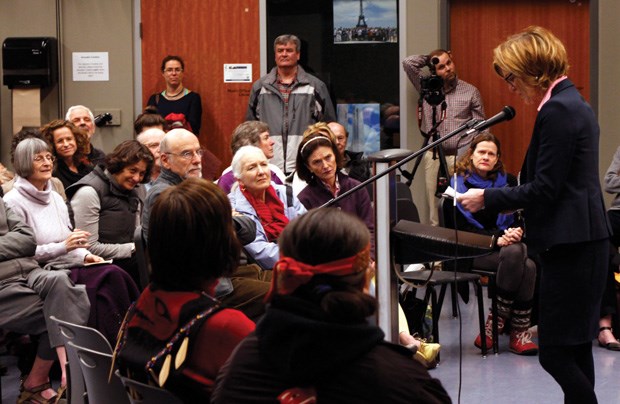Community opposition to a liquefied natural gas export terminal on Howe Sound remains high as the federal government wades into its decision-making process for the plant.
Upwards of 200 residents turned out to a community input meeting at the West Vancouver Community Centre on the Woodfibre LNG proposal on Sunday, most of them opposed.
Howe Sound resident Jackie Deroo said after retiring, she and her husband decided they would tackle environmental issues head-on by advocating for government to make climate change a priority.
“I found myself dealing with my adult son who was in tears,” Deroo said. “He is a mountain climber, wilderness leader ... and he was afraid of the future -- his future. He was afraid of climate change and he asked if we could step up and do something. Newly retired, we said ‘Yes.’”
The Liberal government has been trying to get citizens to step up and share their thoughts at community meetings for pressing issues. Liberal MP for West Vancouver-Sunshine Coast-Sea to Sky Country, Pam Goldsmith-Jones, recently hosted three days of these meetings, drawing residents from all over the Lower Mainland. The province and Squamish Nation have already given tentative approval for the project.
Although the proposed LNG facility would be near Squamish, the impacts of extracting natural gas, building pipelines and using tankers to transport LNG could have disastrous outcomes for many other communities, according to concerned residents.
Deroo said she is “thrilled” with the Liberal government and its commitment to environmental issues, but added the government needed to find a way to reject the Woodfibre LNG project from going through.
“Hundreds of citizens are rising up, thousands of volunteer hours have been spent by people in this room and others, three hundred people yesterday in Squamish. . . . We should not need to do this to fix a broken review process,” she said.
According to Goldsmith-Jones, these community meetings are part of the government’s new approach to energy projects, which include science-based research into environmental effects, consultation with First Nations groups and community input periods.
“This is a new thing for us and it’s the beginning of the way in which we intend to continue on any questions really that face us,” she said, adding that she planned to personally speak with Environment Minister Catherine McKenna, regarding the comments and suggestions from the three meetings.
Up until March 1, the Canadian Environmental Assessment Agency had been accepting public input on the LNG project, either through public forums such as the community meetings or by written correspondence. According to the CEAA’s website, these comments will help McKenna determine whether the project is likely to cause significant adverse environmental effects.
A Feb. 1 report from the CEAA on the estimated greenhouse gas emissions from the project stated that 2.1-million tonnes of LNG per year would be produced if the facility were constructed. The report also stated the LNG could produce as much as 700 to 800 kilotonnes of carbon dioxide per year.
Eoin Finn, founder of the concerned citizens group My Sea to Sky, said these numbers were unacceptable.
“We think that after the commitment on COP 21 (Convention on Climate Change) in Paris, we cannot now start a whole new fossil fuel industry in Canada and hold our heads up in international circles,” he said.
Anton Van Walraven of the group Concerned Citizens Bowen said the group had collected over 1,600 signatures in opposition to the LNG project. His main concern, however, was protecting future generations from the potentially negative environmental effects of the Woodfibre LNG project.
“We should not be talking anymore about building fossil fuel infrastructure,” he said. “I have children myself as well, 12 and 14 years old . . . it’s my responsibility as a parent to make sure their outcome for life will be positive.”



